Tropical Fruits List
If you own a restaurant, you’re probably curious about different ingredients from around the world, and how you can utilize all of them in new, exciting recipes. If you own a juice or smoothie bar, chances are you need to learn how to use a variety of fruits for your menu. Below is a list of tropical fruits so you can bring a bit of the sunny tropics to your menu easily and deliciously. Before starting, make sure all of your fruits are properly washed to keep your customers safe.
Use these links to learn more about specific tropical fruits:
List of Tropical Fruits
Many common tropical fruits are native to the countries that lie along the Earth’s equator. Below is a tropical fruits list so you can become familiar with some of the different types of tropical fruit:
1. Dragon Fruit (Pitaya)

Dragon fruit, otherwise known as Pitaya, has a vibrant pink, thick outer skin with spikey-looking green growths. Dragon fruit is usually pink on the outside with a white or vibrant pink flesh and dotted with small black edible seeds throughout. Dragon fruit can sometimes have yellow skin as well, and this variety only has a white flesh with small black edible seeds.
- What does dragon fruit taste like? Very mild with sweet undertones, reminiscent of a kiwi and pear
- Dragon Fruit Origin: South and Central America as well as Southern Mexico
How to Prepare Dragon Fruit
Cut the dragon fruit down the center lengthwise, exposing the seedy flesh. From here, you can cut it in half again for more exposure to the flesh if you’d like. Now you have a couple of options: you can peel away the skin so you are left with the flesh intact, or you can scoop the flesh away from the skin with a spoon, melon baller, or disher/ice cream scoop. However you do it, be sure to throw away the dragon fruit’s skin because it is inedible.
How to Eat Dragon Fruit
Because dragon fruit has such a mild flavor and beautiful flesh, it’s best to showcase those features. Cut up dragon fruit and toss it into a fruit salad to liven it up, or use it as a topping for smoothie bowls or yogurt parfaits. You can also use dragon fruit in a smoothie or as the base of a smoothie bowl, especially if you have the hot pink-fleshed pitaya.
What Goes with Dragon Fruit?
Fruits that go well with dragon fruit are pineapple, mango, bananas, oranges, papaya, strawberries, and lemon.
Shop All Frozen Dragon FruitBack to Top
2. Passion Fruit (Liliko'i)
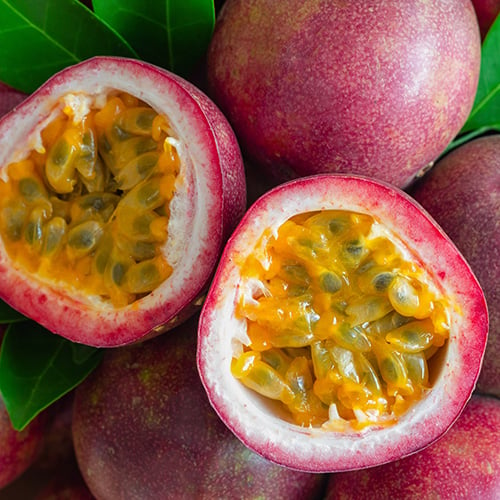
Passion fruit, otherwise known as Liliko'i in Hawaiian, is a type of tropical fruit that has a hard purple or yellow outer shell with a jelly-like golden pulp and seed-filled center. The purple passion fruit will have black seeds and the yellow liliko'i will have brown seeds. Passion fruit seeds are crunchy and edible, but tart-tasting.
- What does passion fruit taste like? Acidic, tart, and surprisingly sweet compared to the other tasting notes
- Passion Fruit Origin: Subtropical regions of South America, such as Brazil, Bolivia, Argentina, Uruguay, and Paraguay
How to Prepare Passion Fruit
When your passion fruit’s outer skin is wrinkly, it’s perfectly ripe and ready to prepare. To start the preparation of the passion fruit, cut it in half with a serrated knife to make a clean cut. Next, take a spoon and scoop out the pulp. Whether you’re scooping out the passion fruit pulp into a clean bowl, fine-mesh sieve, or on top of a cake or pie is up to you and your recipe!
How to Eat Passion Fruit
The pulp of the passion fruit and the seeds of the passion fruit can be eaten as is and are great scooped onto a cake, pie, pavlova, or smoothie bowl to create a beautiful finishing touch thanks to the vibrant colors. Try using passion fruit to make a lilikoi butter, AKA passion fruit curd, and use it in malasadas and other donuts, passion fruit bars, as a filling for cakes or pate a choux, or in pavlovas. It also adds a healthy burst of flavor to smoothies or raw vegan desserts. Passion fruit also makes an excellent syrup to flavor cocktails.
What Goes with Passion Fruit?
Fruits that go well with passion fruit are papaya, melons, banana, mangoes, and vanilla. Passion fruit also pairs extremely well with milk-based foods like yogurt, cream, and custard. Passion fruit pairs well with other bitter and tart fruits when there is a large amount of milk-based products in the recipe, like a lemon and passion fruit cheesecake.
Shop All Frozen Passion FruitBack to Top
3. Rambutan
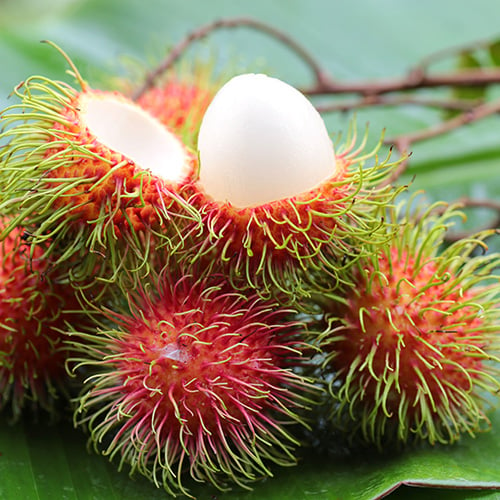
Rambutan is a tropical fruit with a red shell and soft, hair-like spikes surrounding the outside of the red shell. Rambutans are plum-sized, and under their red skin is a soft, translucent, grape-like fruit with an inedible brown seed in the middle of the fruit.
- What does rambutan taste like? Sweet, slightly astringent, with strawberry notes
- Rambutan Origin: Southeast Asia, Australia, and Hawaii
How to Prepare Rambutan
To prepare a rambutan, take a sharp knife and carefully peel away the red skin. There may come a point where you can peel the skin away by hand. You should be left with the translucent flesh. Break open the flesh and take out the inedible seed. Now you are left with just the sweet fruit!
How to Use Rambutan
Rambutan is great raw and by itself, but there are plenty of ways to use them in other recipes. Add rambutan into a fruit salad, or try sticking a toothpick or cocktail pick through them and placing the rambutan in a drink as a garnish. Try rambutans in a sorbet, or plop them into a blender with frozen fruits and make a smoothie or smoothie bowl.
What Goes with Rambutan?
Fruits that go well with rambutan are other fruits that have a lot of flavors, such as mango, lemon, lime, coconut, pineapple, and passion fruit. Try basil or mint when pairing rambutan with herbs.
Back to Top
4. Acai
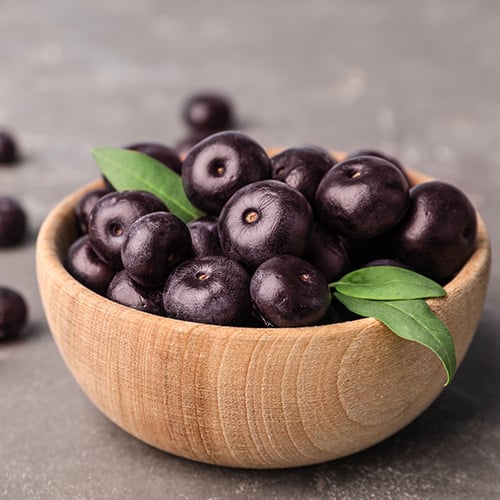
Acai (pronounced “ah-sigh-ee”) are small, dark purple berries that are loaded with tons of health benefits. In the United States, acai is found pre-pureed, frozen, scooped into plastic packets, then sold at grocery stores. It can only be served frozen because the juice from acai berries must be eaten within 24 hours of extraction. In the Amazon, acai berries are soaked to soften the skin, then mashed to form a paste. The acai paste oftentimes accompanies savory meals with fish or cassava, or is made into ice cream or acai bowls.
- What does acai taste like? Earthy and creamy, with unsweetened chocolate and blackberry notes
- Acai Origin: Amazon rainforest, Central and South America
How to Use Acai
Acai is most notably known for making acai bowls. Acai can also be used for smoothies, raw vegan desserts, ice cream, sorbet, or popsicles.
What Goes with Acai?
Fruits that go well with acai are bananas, blueberries, strawberries, coconut, passion fruit, pineapple, oranges, cacao, dragon fruit, and cherries. Other great pairings are nut butter, granola, chocolate spreads, and sweeteners like guarana, honey, agave, or maple syrup.
Shop All Frozen AcaiBack to Top
5. Jackfruit
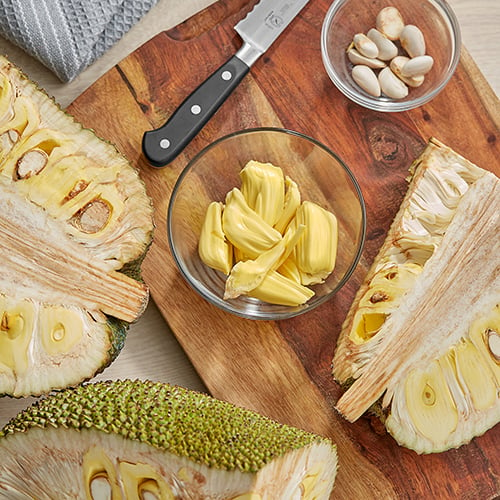
Jackfruit is a tropical fruit with an impressive size of anywhere between 8 inches to 3 feet tall, with its weight varying even greater at 10 to 110 pounds! The outside of the jackfruit has a green spiky skin that’s thick and unyielding. Inside, there is a white, fibrous surface that holds the golden yellow jackfruit pods. The jackfruit pods are the edible part of the jackfruit, and each pod has a seed on the inside that is edible after boiling.
- What does jackfruit taste like? Unripened jackfruit tastes mild with a small hint of sweetness, and ripe jackfruit tastes very syrupy-sweet with tangy undertones
- Jackfruit Origin: South and Southeast Asia, Africa, and South America
How to Prepare Jackfruit
To cut jackfruit, take a sharp knife and carefully lather oil on the blade. Pierce the knife through the jackfruit’s skin and cut the jackfruit in half length-wise. Once it’s opened, cut out the white sappy core. You should now have the golden-yellow jackfruits pods exposed. By hand, take out the jackfruit from its pods, and place it into a bowl to use the fruit when ready. Remove the seed inside of the jackfruit, but make sure to save the seeds to boil and eat as they’re packed with extra nutrients!
How to Use Jackfruit
Jackfruit has tons of different uses, and the use depends on how ripe the jackfruit is. If the jackfruit is unripe, then it is best for vegan and vegetarian food as a meat substitute due to its texture and mild, unripe flavor. Use unripe jackfruit for vegan BBQ pulled jackfruit sandwiches, stir-fries, curries, teriyaki bowls, Jamaican jerk jackfruit wraps, vegan pot pie, jackfruit crab cakes, and barbacoa jackfruit tacos.
If you’re using ripe jackfruit, it’s really great eaten as is, but jackfruit can also be tossed into a fruit salad or smoothie for an unexpected fruit. Jackfruit also is traditionally made into kathaler mishti pakora, which is sweet jackfruit fritters, or made into chakka varatti, which is jackfruit jam. Jackfruit has even been used in quick bread such as muffins and bread loaves when paired with other tropical fruits like coconut and bananas. You can even try making a brown sugar jackfruit upside-down cake!
What Goes with Jackfruit?
Fruits that go well with jackfruit are mangoes, pineapples, bananas, and coconut. Darker sweeteners also pair well with jackfruit, like molasses, brown sugar, date syrup, and jaggery.
Back to Top
6. Mangosteen
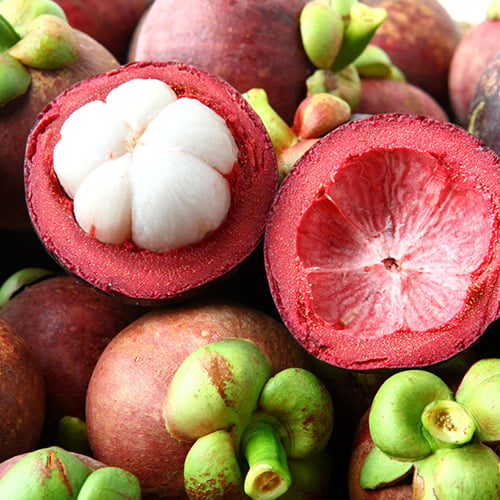
Mangosteen is a type of tropical fruit that has a purple outer shell with beautiful translucent-white fruit on the inside. The fruit is naturally sectioned off into segments, and you can tell how many segments will be in the mangosteen by looking at the bottom of the mangosteen at the flat, flower-shaped growth and counting the “petals” that the flower shape has. When opened, the smaller segments tend to have no seeds, while the bigger segments usually have an inedible seed.
- What does mangosteen taste like? Pineapple, strawberry, and lychee
- Mangosteen Origin: Southeast Asia, more notably the Sunda Islands
How to Open Mangosteen
Press firmly with your thumb into the purple skin of the mangosteen until you break the skin, then peel away the rest of the skin. You should now be left with the mangosteen fruit segments as well as the seeds inside. If the skin is too hard to crack open with your hands, use a serrated knife to carefully cut a 1/4” deep incision around the circumference of the mangosteen and lift away the top. From there you can pull apart the rest of the skin of the mangosteen.
How to Use Mangosteen
Mangosteens are best eaten raw as is right from their shell, but they’re also nice when tossed in a fruit salad with lime or mint syrup. They’re also great in a smoothie, made into ice cream, or used in traditional Asian desserts, just be sure to take out the seeds first!
What Goes with Mangosteen?
Fruits that go well with mangosteen are strawberries, bananas, papayas, passionfruit, and pineapple.
Different Types of Mangosteens
There are a couple of different types of mangosteens as well that are also worth noting:
Lemon mangosteen (Gamboge)
Lemon mangosteen, also known as gamboge, has a bright yellow outer shell with matching fruit. The fruit has the texture of a mango, the flavor of a lemon, and is high in vitamin C. The inside of the fruit has a large, inedible seed, and the skin of the lemon mangosteen is edible.
African Mangosteen (Imbe)
African mangosteen, otherwise known as imbe, is a kumquat-sized fruit that has a thin and vibrant orange outer skin that peels by hand very easily. It can have one or two very large seeds in the middle and does not yield a lot of fruit. Therefore, it is usually used for ornamental decor. African mangosteens taste sour, tart, and slightly sweet with mango-like undertones.
Back to Top
7. Lychee

Lychee is a tropical fruit with a thin, hard, and easily breakable pink skin with translucent-white flesh underneath. The fruit has a large, inedible seed in the middle. Lychee fruit is usually the size of a grape.
- What does lychee taste like? A cross between a watermelon and a strawberry
- Lychee Origin: Southeast Asia
How to Prepare Lychee
To peel the skin off lychee, break open the hard skin with your nail, and start to peel away the rest of the skin and discard. You should be left with the white-translucent fruit with the inedible seed on the inside. To remove the seed, score the white fruit down the center and pluck out the seed. There may be leftover seed membrane stuck on the inside, which is edible and very difficult to remove.
How to Use Lychee
Lychee is great eaten raw, so enjoy as is or toss it in a fruit salad. You can also put lychee into a smoothie, use it to make ice cream, or make various Asian desserts that traditionally use lychee. Lychee syrup is great for cocktails, especially if you have access to lychee fruit and can use it as a garnish. Because of lychee’s mild sweetness, it’s a perfect ingredient to add dynamism to savory dishes, such as sweet and sour sauces for stir-fries, or even barbecue sauces if you want to take your grilled meats up a notch.
What Goes with Lychee?
Fruits that go well with lychee are pineapple, citruses, mango, coconut, banana, and passion fruit, and most tropical fruits. When pairing lychee in cocktails, try using tequila, vodka, and sake, with a small splash of vanilla to bring it all together.
Shop All Frozen Lychee PureeBack to Top
8. Papaya
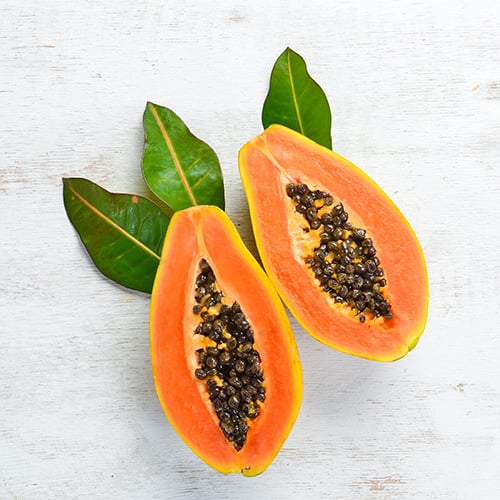
Papaya is a large, teardrop-shaped fruit with a green or yellow, thin, and yielding outer skin. The inside is a luscious, soft, and salmon-colored fruit with a cluster of black, shiny, and small seeds that are edible, but should only be consumed in moderation.
- What does papaya taste like? Mild and slightly sweet with a creamy and spoonable texture
- Papaya Origin Central America
How to Prepare Papaya
Cut the papaya in half length-wise to expose the black seeds. Scoop out the black seeds and discard. Now, run a knife right on the edge of where the pink fruit meets the green skin to separate the two. Or, you can scoop out the fruit away from the skin. You should now be left with just the fruit of the papaya.
Another option to cut the papaya is cutting off an inch from the bottom to let the papaya stand on a flatter surface. Stand your papaya on its new flat surface, take your knife, and carefully peel off the skin of the papaya. Now, cut the papaya in half length-wise and scoop out the seeds. You should now be left with just the pink flesh of the papaya.
How to Use Papaya
Papaya halves still in their skin with the seeds scooped can be eaten as-is with a squeeze of lime or with passionfruit spooned on top of it. Papaya also makes a perfect base for a smoothie thanks to its texture and mild flavor. You can also use papaya for yogurt bowl toppings, chopped into salsa, or broken down into a jam. Papayas can also be used in salads as a pop of freshness.
What Goes with Papaya?
Fruits that go well with papaya are passion fruit, lychee, mango, guava, pineapple, and strawberries. The tangier the fruit, the better, as papayas mild taste could use a complementing but outstanding flavor pairing. Otherwise, it can also pair well with more mellow fruits, such as dragon fruits, melon, bananas, and mangosteen.
Shop All Frozen PapayaBack to Top
9. Guava
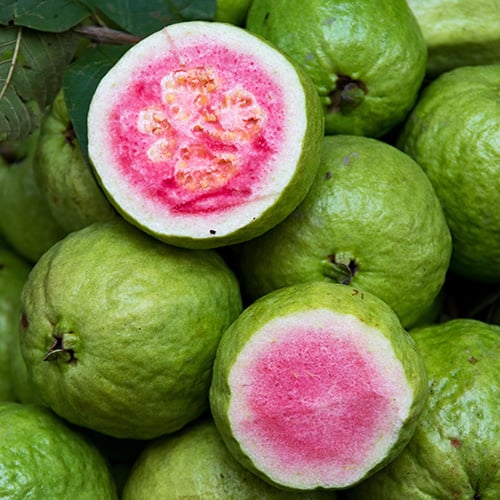
Guava is a type of tropical fruit with a think green-yellow outer skin and pink or white center. Guava is around the size of an apple, and when ripe it should be very juicy and soft. The skin and seeds of guava are edible as well!
- What does guava taste like? Fruity and floral with notes of strawberry
- Guava Origin: Mexico, Central America, South America’s northern region, as well as the Caribbean
How to Prepare Guava
Cut the guava in half length-wise to expose the flesh. From here you can cut per your recipe, or scoop out the flesh and use immediately or refrigerate/freeze the guava until ready for use.
How to Use Guava
Guava is traditionally served simply with either salt, chili powder, or plum powder sprinkled on. Guava also makes a fantastic smoothie or smoothie bowl base. Jam is also another great use for guava, or a guava syrup that can be used in cocktails. Guava has been used in barbecue sauces for an extra pop of a sweet flavor on meat and fish!
What Goes with Guava?
Fruits that go well with guava are cherries, apricots, plums, strawberries, coconut, mangoes, bananas, pineapple, pear, and citrus fruits.
Shop All Frozen Guava PureeTropical Fruits List Chart
Check out our tropical fruits infographic below for a fun visual guide!
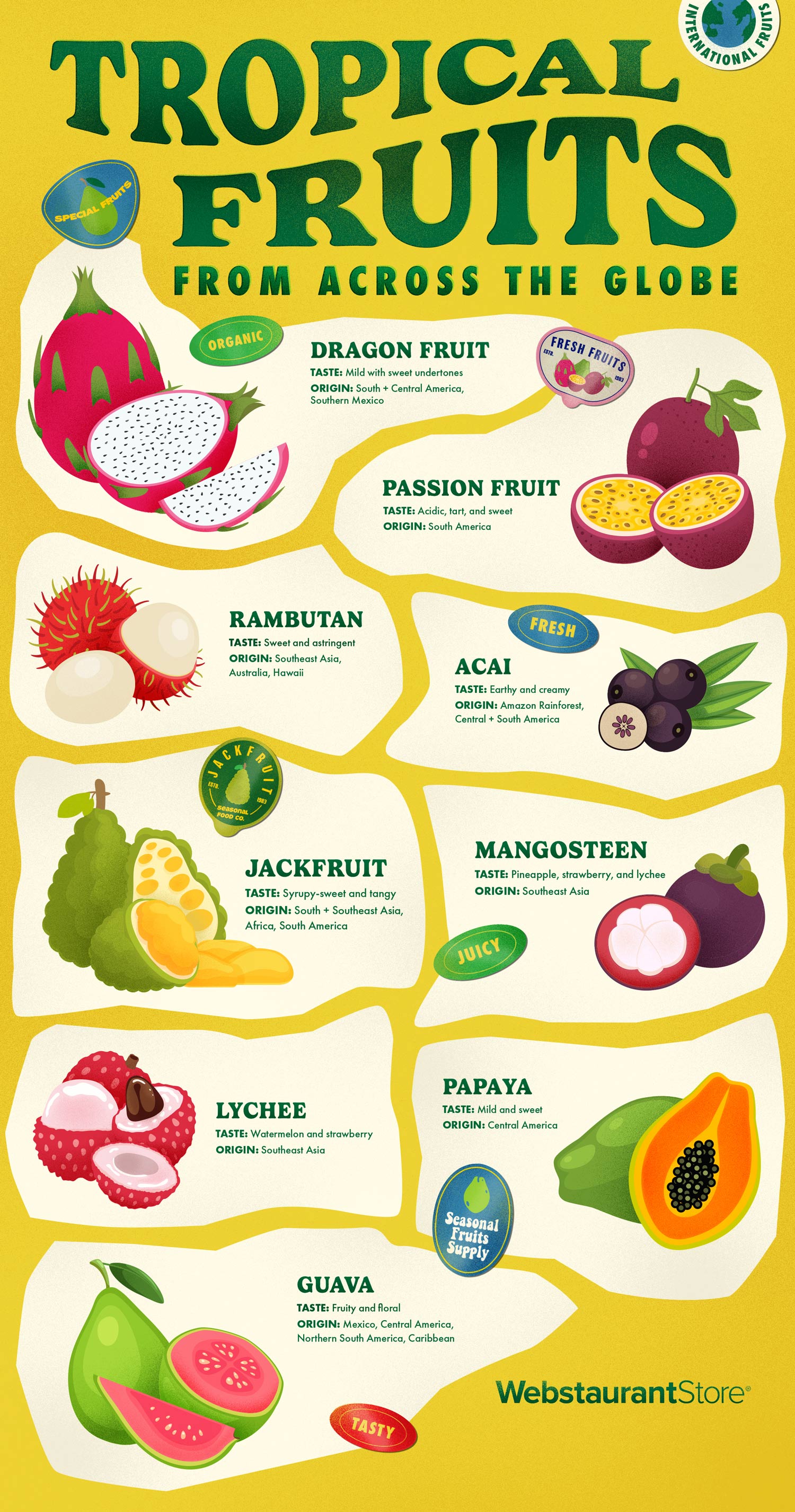
Tropical fruits are filled with flavor, color, and added nutrients, and using them to create traditional or innovative menu options is a great way to stand out from the competition if these are not the usual fruits that grow in your region.



